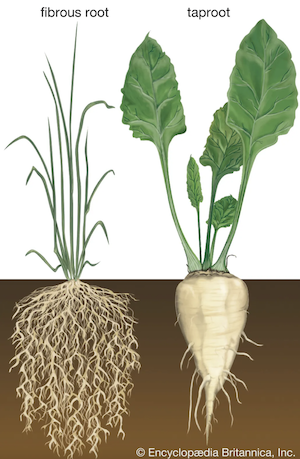RESEARCH | Plant root systems¶

PLANT ROOT SYSTEM¶
Plants use roots for several essential functions, including anchoring, water absorption, mineral absorption and storage, and transportation of nutrients to other parts of the roots. While the purposes are similar for different plants, there are two distinct root systems based on whether the plant is a monocotyledon (grasses) or dicotyledon (flowers). The fibrous root system is found in monocotyledons, while dicotyledons have a taproot system. Fibrous root systems are shallower (soil surface) and have a dense network of roots, while taproots have a large main root with smaller roots branching off.
The growth of roots starts when a plant germinates from a seed and it doesn't have a fixed endpoint. This growth happens at the stem's bottom and is driven by the division of cells in the root apical meristems. Roots are made up of cylindrical tissue systems arranged concentrically. These systems are the dermis system, ground system, and vascular systems, from the outside in. At the tip of the root, there's the root cap, which guards the apical meristem and aids the root's advancement through the soil. Above this section, the root's length can be divided into three zones: the zone of cell division, the zone of cell elongation, and the zone of cell maturation. The zone of cell elongation, located above the root apical meristem, is responsible for the root's penetration through the soil. Conversely, the zone of cell maturation is where the cells finish their differentiation.(Encyclopaedia Britannica, 2023)
